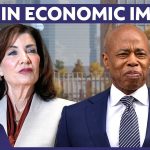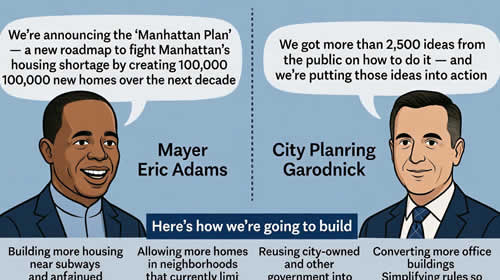MS. JEAN-PIERRE: All right. I got ahead of myself.
All right, guys. We’re headed to New York City — my home city and state — New York.
All right, here we go.
So, since his first days in office, the President has demonstrated his commitment to diversity, creating a government that looks like America, a commitment that extends to the highest levels of his Cabinet and the highest court in the land.
For months, the White House has been meeting with civil rights organizations, universities, and legal organizations to prepare for this decision in the event that the Supreme Court struck down affirmative action.
The stakeholders shared with us that they would need guidance on what this ruling would mean, and they would need — need it before the start of the admission cycle to avoid confusion.
The White House, led by the DPC, the Office of Public Engagement, and Counsel’s Office worked over the last few months with DOJ and — and Ed to develop a response plan.
Throughout the process, the President was clear with his team that diversity was one of America’s greatest strengths, that we needed to make sure that his — that this decision wouldn’t be a permanent step back for the country, and we would need a way forward to protect diversity and opportunity in America for everyone.
The President met regularly with his team over the last month to gear up a response that encourages college — colleges and universities to recognize when a student has had to overcome system- — systemic barriers and ine- — inequities, and value that in the admissions process.
This morning, when the decision came down, the President was briefed by counsel, then convened a meeting with members of his senior staff closely working on this issue.
The President directed his team to finalize our plan to support colleges and universities before the admission — admission process starts.
The White House has directed the Department of Ed to analyze what other practices and tools exist to help build more inclusive and diverse student bodies.
Also, another piece of significant news we want to highlight today, which is something that we announced, I believe, yesterday: Last year, the VA moved 40,000 homeless veterans into permanent housing, and today, the Biden-Harris administration is announcing a series of additional actions to prevent and reduce veterans homeless- — veteran homelessness.
The administration will invest an unprecedented $3.1 billion to help communities across the country quickly rehouse people experiencing homelessness, including veterans. This will be the single largest investment in communities’ homeless — homelessness response system in history.
We are also providing new legal services for veterans experiencing or at risk for homelessness and the funding programs to help veterans experiencing or at risk of homelessness find jobs and connect to work.
President Biden believes that every veteran deserves a roof over their head. And these announcements build upon historic actions the administration has already taken to reduce the number of veterans experiencing homelessness, which has fallen by 11 percent since 2020 and more than 55 percent since 2010.
With that, Zeke, you want to kick us off?
Q Thanks, Karine. When will that Department of Ed guidance be promulgated? And will — what assurances have you gotten from universities, or which universities have said that they will follow that guidance now — now that the Supreme Court has ruled?
MS. JEAN-PIERRE: So, the Department of Ed and also, let’s not forget, the Department of Justice, as well, will provide resources to colleges and universities addressing lawful admissions practices within the next 45 days as colleges prepare for the next application cycle. So that’s, kind of, about that time.
The Department of Education will also provide assistance to colleges and university administering programs to support students from underser- — underserved communities.
And also, in addition, the Department of Education will host a national summit that’s going to be focused on equal opportunity in post-secondary education. That’s going to happen next month. And that’s going to be with advocates; student leaders; college and university administrators; researchers; and state, local, and, let’s not forget, the Tribal community, as well — those leaders — to share lessons learned, innovative strategies, and develop additional resources for colleges and students to expand to educational opportunities.
So, this is going to be a summer- — as you all can imagine, a summer-long process to make sure that the colleges and universities feel prepared and ready and have the resources they need as we head into the next academic year.
Q Karine, the President — when the President took office, he launched a Supreme Court review panel. They did meetings. They came back to him with a very lengthy report. He’s had that report for months now. We’ve never heard from him on what his analysis was on what reforms need to be done to a body that, today, he said is not normal. Where is he on that?
MS. JEAN-PIERRE: So, look, as it relates to the commission: Look, he read the report — I know that was a question that I got often in the briefing room — and he’s very grateful to that commission. Let’s not forget, it was a diverse, bipartisan group of constitutional and legal expert- — experts — right? — who contributed to do this — to bring this together in an effort to applying the most collective expertise on Court reform and proposal in decades.
And so, look, we have — we have their report. He’s read it. I don’t have anything — any decisions or anything to read out on — on anything th- — moving forward on that particular report.
But, again, it was a — certainly an important exercise to make sure we bring in legal experts from both sides, in a bipartisan way, to kind of take a look — take a look at the courts.
I’m not going to go beyond what the President shared with all of you, or some of you, who were in the Roosevelt Room when he was asked about the — the Court specifically.
Q So he’s not going to endorse any particular part of that report? He’s — it’s just going to sit on the shelf and collect dust, basically?
MS. JEAN-PIERRE: I mean, I wouldn’t say it’s col- — it’s sitting on the shelf and collecting dust. I would say that it was an important report, and it was done by — by a diverse — both, you know, Republicans and Democrats — right? — a bipartisan group of people who came together and put this report together. I think that’s important. That’s — we’ve never seen that before, and that is an action that the President wanted to take so he — we can get a sense of what legal experts have to say.
We just don’t have anything to announce as — as any additional steps to move forward on — on any specifics on the report.
The President obviously read it and took a look at it. I just don’t have anything more to share. But I wouldn’t say — I would say it’s — you know, I think it was an important report to have. Again, it’s never happened before, and I think it’s — it’s important that the President asked to be done.
Q Karine, can I ask two quick ones on —
MS. JEAN-PIERRE: Yeah, absolutely.
Q — the President’s health?
MS. JEAN-PIERRE: Absolutely.
Q Obviously, his use of a CPAP machine was disclosed yesterday, and it’s something that many Americans use with sleep apnea. But what I’m wondering is: What happened in the last couple of weeks that led him to use it? Was it he was feeling tired? The First Lady was complaining about his snoring? (Laughter.) What — can you give us some background on what happened here?
MS. JEAN-PIERRE: So, as you know, the President disclosed this, I think, like 15 years ago — the sleep apnea. So it’s nothing new. It’s out there, certainly, in the record.
And as you just mentioned, and many of you have covered this, 30 million people across the country, certainly, deal with sleep apnea, of all ages.
One of the things that I can say is that — I think the thing that’s important is: It’s for better sleep. Right? I think that’s one of the reasons that — that it was — it was kind of added. It —
Q So he was feeling tired, rundown a little?
MS. JEAN-PIERRE: No, I mean, I — I’m not going to get into how the President is feeling. What I can say is: One of the important things is getting better sleep. I think all of us can understand that, how important that can be. And — and so this is what the — this is what the — it gives the opportunity the — for the President to do.
Just don’t have anything else to add. It — I — you know, it was something that was done within the last couple of weeks. Don’t have a specific date on that. But what it allows — which is, I think, it really important for the President — is to, you know, make sure he’s getting as much sleep as he can.
Q Ever since — well, maybe not directly, but shortly after the President had his sandbag stumble at the Air Force Academy, he has been using the lower steps on Air Force One instead of the, kind of, truck that drives up. I’m wondering if that is because he’s been having mobility problems of any ty- — type, if it’s to address — you know, he’s had a couple incidents falling on the stairs getting up and you guys just decided that it would be better for him. Can you walk me through —
MS. JEAN-PIERRE: So I don’t have —
Q — what’s going on there?
MS. JEAN-PIERRE: I don’t have any decision process to walk through. I’m sure there’s a protocol that’s used for the — for Air Force One. I just don’t have one.
I mean, you guys see the President every day, when it — to speak to — when you — when we speak to mobility. The President always says watch him.
You know, he was a — this was a president — let’s not forget, he went to a warzone country in Ukraine and did that in a way that was incredibly effective. The world got to see him out there and meet with President Zelenskyy. And I think that’s incredibly important.
I just don’t have anything to share on (inaudible).
Q I — I guess just to, like — to buttonhole it —
MS. JEAN-PIERRE: Yeah. Yeah.
Q — you know, we’ve seen a change in the medical technology he’s using, we’ve seen a behavioral change here.
Is there anything that you guys are seeing that represents a medical change of any sort with the President?
MS. JEAN-PIERRE: So, look, if you look at what — what we have put forward, as far as his medical — the President’s medical report, it is more comprehensive and extensive than any other president. You guys have in front of you, if — and we’ve presented to all of you memos —
Q Well, in February. And these —
MS. JEAN-PIERRE: Well, I mean —
Q — things have happened since then, and that’s why.
MS. JEAN-PIERRE: Well, I mean — no, I understand, but it is this year, and it has been extensive, it has been comprehensive — more than any other president. I — that still remains to be the fact.
And — and we’ve been pretty transparent about that, even with — even with when you all asked us about — about, you know, yesterday, and we — we said it was related to sleep apnea. We were very transparent about that, and we responded very quickly.
And so, look, again, we have put forward the most comprehensive medical report of the President, and I think that’s important. We’ve been very — when asked questions about — about what you all may have noticed, like yesterday, we’ve been very clear about that as well.
I just don’t have anything else to detail.
The President — shoot, he — he traveled yesterday. He’s traveling today. You saw how extensively he traveled during — during the midterms — he — and especially in his foreign travel. This is someone who is incredibly active as president and will continue to do so. That will not change.
Q Karine, I just had a question that’s a follow-up on the President’s health. Are there any plans for the President’s physician to brief the press about his health?
MS. JEAN-PIERRE: No.
Q And then I have one more question.
MS. JEAN-PIERRE: Yeah.
Q Who’s paying for this trip today? Because there are no standard public administration-wide ef- — events. Is the campaign reimbursing for this trip? Or —
MS. JEAN-PIERRE: I have an answer for that. But the first one — what was the first question again?
Q The first question was: Are there any plans for the President’s physician to brief the press?
MS. JEAN-PIERRE: Oh, no, there’s no plans. Look, we put — we put forward a very comprehensive memos on the President’s health. I would refer you to that. No plans for the doctor to — to brief the press.
As it relates to the trip, it’s a mixed — mixed travel trip with official and political — political portions. Associated — associated expenses are allocated and paid for in accordance with federal regulations.
Q What’s the official part of this trip?
MS. JEAN-PIERRE: Let me — let me — let me finish.
You all are always criticizing the President for not doing enough interviews — right? — and today, the President has chose to do in studio, live, on the to- — on top of the rated — on the top-rated show at four o’clock, which draws over 3 million-plus viewers over its two hours, to discuss issues of consequences to the American people: the economy, war on the European continent, our democracy, and possibility — also major rulings for the Supreme Court that would impact millions of people.
And so —
Q Was there any discussion of having the interview in Washington, D.C., or was it always going to be in New York?
MS. JEAN-PIERRE: Well, look, he’s going to New York, and we took the opportunity to go in studio. It’s his first in-studio interview. And we think it’s important to make sure that we’re in front of three — three-plus million people to talk about Bidenomics — right? — to talk about what’s going on around the world, to talk about all the things that is critical to the American people. And that’s what you’re going to see from the President today.
Q Thank you, Karine.
WH.GOV OFFICIAL WHITE HOUSE NEWS
Video from White House: Vice President Harris Participates in a Moderated Conversation on Advancing Economic Opportunity










